Festivals Of Karnataka: List Of most Famous of Festivals, Rituals
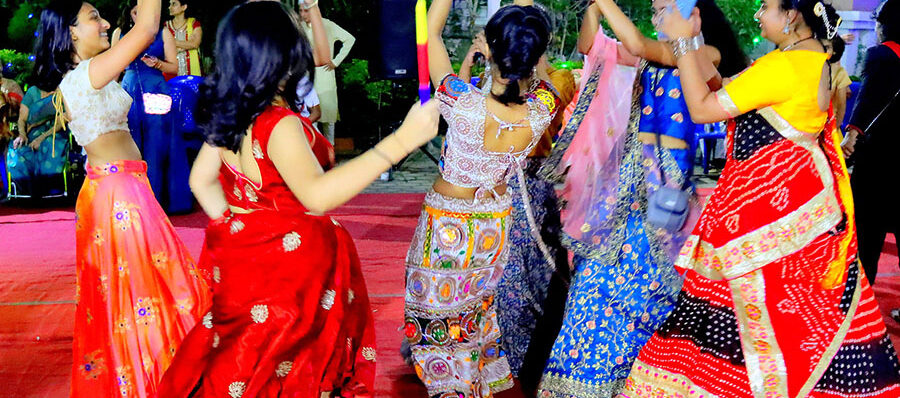
Karnataka stands as a vibrant state in South India, renowned for its diverse culture, rich history, and exuberant festivals. These celebrations beautifully blend religious significance with local customs, drawing visitors from all over the world. The state’s festivals highlight its deep-rooted traditions, spiritual fervor, and communal harmony. Whether you’re a spiritual seeker or a cultural enthusiast, Karnataka’s festivals offer a delightful glimpse into its heritage.
This detailed guide explores Karnataka’s major festivals, their significance, and the rituals that make each one unique.
1. Mysuru Dasara – The Royal Festival of Karnataka
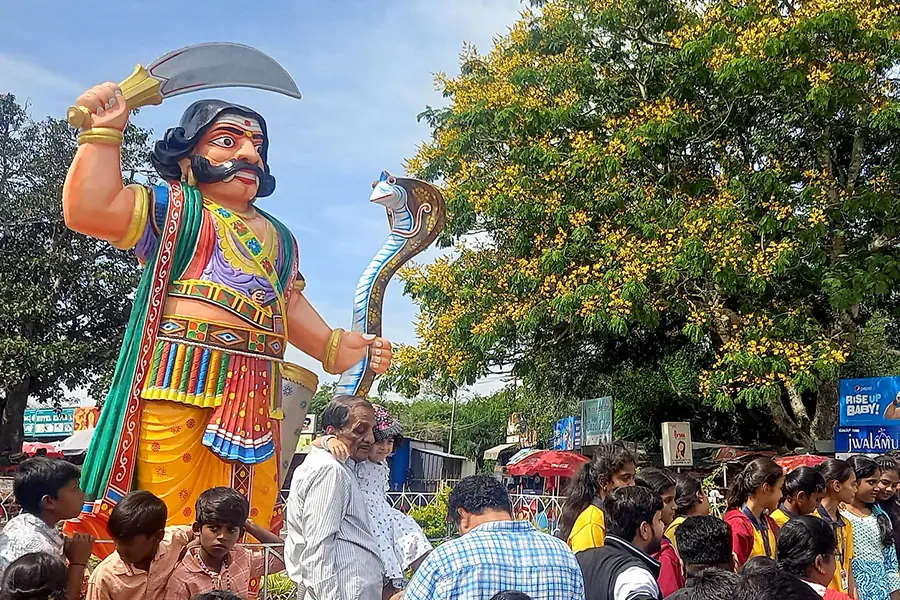
Mysuru Dasara, also known as Nadahabba, ranks as the most famous and grand festival in Karnataka. Celebrated over ten days during Navaratri, it honors Goddess Chamundeshwari, the deity of the state. The festival culminates in the Vijayadashami procession, marking the victory of good over evil.
Highlights of Mysuru Dasara:
- Jumbo Savari (elephant procession) carries the idol of Chamundeshwari in a golden howdah.
- The Torchlight Parade on the final night occurs at Bannimantap Grounds.
- Cultural performances showcase Karnataka’s art, music, and dance traditions.
- Mysore Palace illumination with over 100,000 lights creates a mesmerizing view.
Mysuru Dasara attracts tourists from around the world, celebrated with unmatched grandeur and elegance.
2. Ugadi – The Kannada New Year
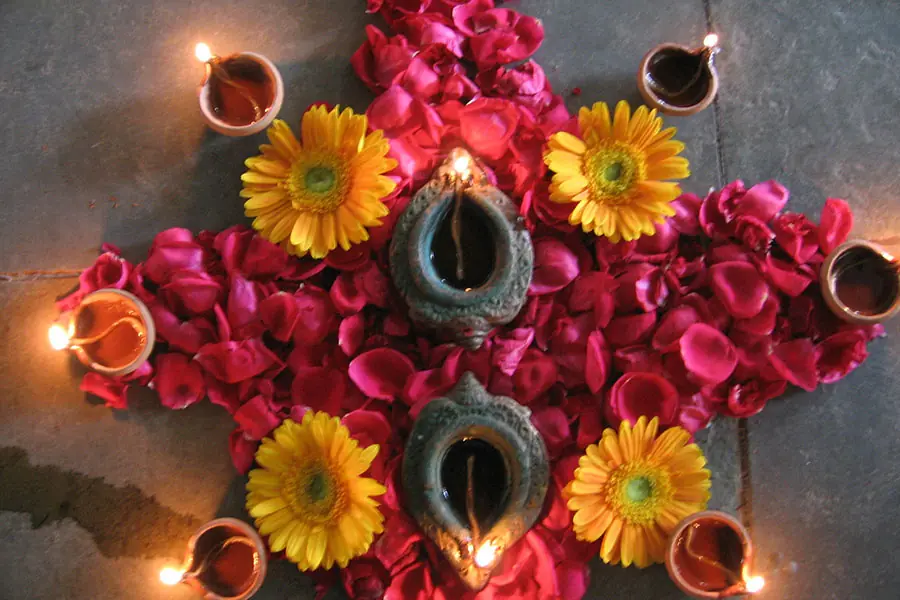
Ugadi marks Karnataka’s New Year and is celebrated with immense joy and devotion. It falls on the first day of Chaitra, symbolizing the start of a new year in the Hindu lunar calendar.
Significance of Ugadi:
- People clean and decorate their homes with mango leaves and rangoli.
- The day includes Panchanga Shravanam, where priests read the new almanac to predict the year ahead.
- Special dishes, such as Ugadi Pachadi, represent the different flavors of life.
- Families wear new clothes and visit temples for blessings.
Ugadi celebrates the renewal of hope and prosperity for the upcoming year.
3. Kambala – The Buffalo Racing Festival
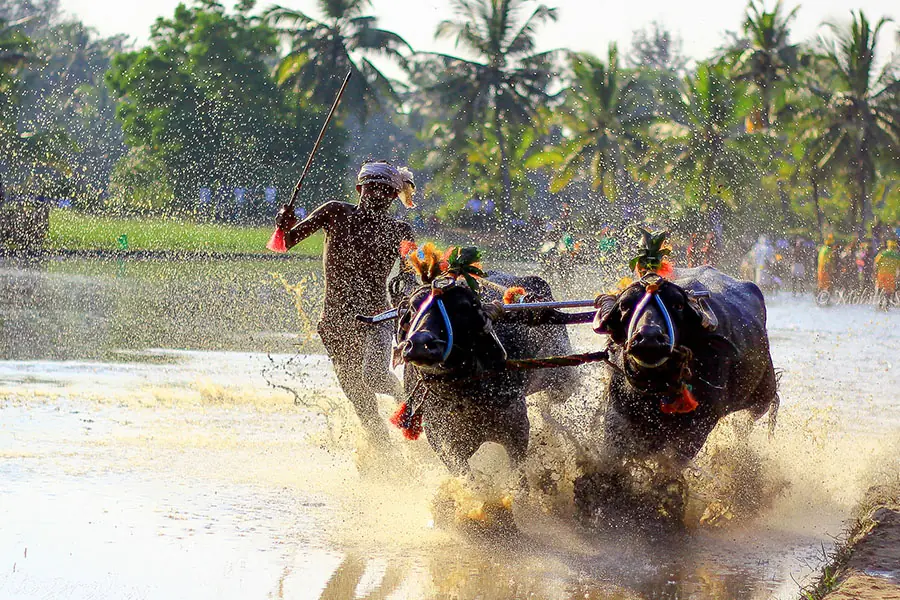
Kambala, a traditional buffalo race, takes place in the coastal regions of Karnataka, especially in Mangalore and Udupi. The festival typically follows the harvest season and celebrates the region’s agricultural spirit.
Key Features of Kambala:
- Pairs of buffaloes race through slushy paddy fields, competing for the fastest time.
- The event honors Lord Kadri Manjunatha and other deities associated with agriculture.
- Local communities gather to cheer on the racers and share folklore.
Kambala highlights Karnataka’s agricultural roots and rural sport.
4. Karaga – The Festival of the Tigress Goddess
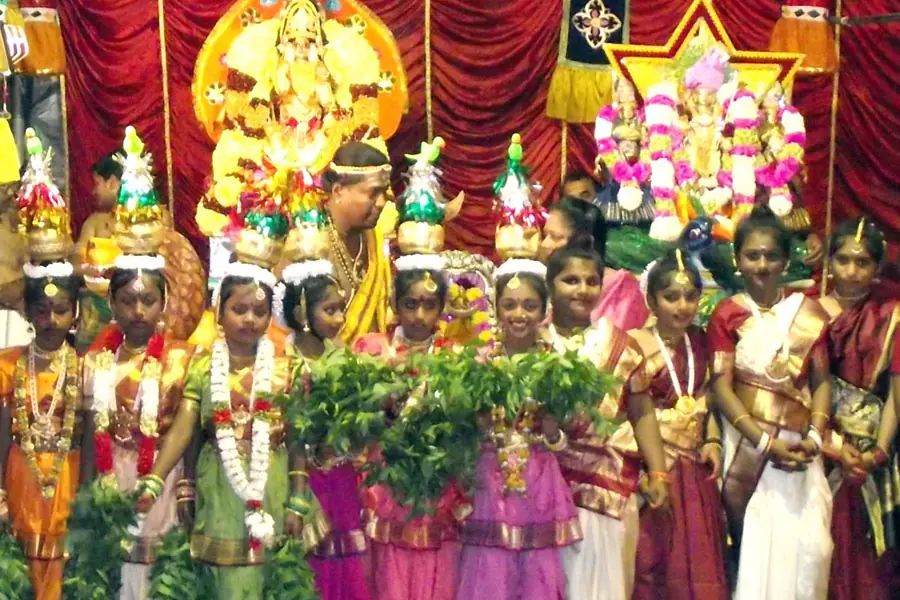
Karaga, one of the oldest festivals in Bengaluru, is dedicated to Draupadi, who is considered an incarnation of Goddess Shakti. The festival symbolizes the victory of good over evil.
Highlights of Karaga:
- A priest, dressed as Draupadi, carries a sacred earthen pot (Karaga) on his head during a grand procession at night.
- The procession passes through several temples in the city, representing the goddess’s journey.
- Sword-wielding Veerakumaras and music from traditional instruments such as Nadaswaram and Dhol accompany the procession.
Rooted in the Mahabharata, Karaga’s spiritual significance remains essential to the Draupadi cult in southern Karnataka.
5. Makar Sankranti – Harvest Festival

Makar Sankranti celebrates the sun’s transition into Capricorn and marks the beginning of the harvest season across Karnataka. It also symbolizes the end of winter.
Key Rituals of Makar Sankranti:
- Families prepare Ellu-Bella, a mixture of sesame seeds, jaggery, and coconut, to symbolize goodwill.
- People take holy dips in rivers and visit temples for blessings.
- Popular activities include kite flying and bullock races in rural areas.
Makar Sankranti brings a sense of renewal, signaling a time of hope and prosperity.
6. Gowri Habba – Worship of Goddess Gowri
Gowri Habba, observed a day before Ganesh Chaturthi, honors Goddess Gowri (Parvati), the mother of Lord Ganesha. Married women celebrate the festival by praying for the well-being of their families.
Rituals of Gowri Habba:
- Women install an idol of Goddess Gowri at home, decorated with flowers, kumkum, and turmeric.
- They perform Puja and offer mangala dravya (auspicious items) to other married women.
- Special dishes such as Kayi Holige (coconut-stuffed sweet) are prepared as offerings.
The festival celebrates the power of womanhood and family ties.
7. Ganesh Chaturthi – The Festival of Lord Ganesha

Ganesh Chaturthi celebrates the birth of Lord Ganesha, the remover of obstacles. While the festival has a nationwide presence, Karnataka’s focus on eco-friendly Ganesha idols and local traditions stands out.
Celebrations Include:
- Families and communities install beautifully crafted Ganesha idols in homes and public spaces.
- Visarjan (immersion) processions follow, with music, dancing, and celebration.
- Offerings of modakas (sweet dumplings) and other special dishes are made to Lord Ganesha.
Ganesh Chaturthi fosters unity and joy through devotion and communal gatherings.
8. Varamahalakshmi Vrata – Worship of Goddess Lakshmi

Varamahalakshmi Vrata involves worshiping Goddess Lakshmi, the deity of wealth and prosperity. Women observe this festival, praying for the well-being of their families.
Key Rituals:
- Women create Kalasha (a sacred pot) representing Goddess Lakshmi and perform elaborate Puja.
- They offer fruits, sweets, and new clothes to the goddess.
- Married women invite friends and neighbors to share blessings and feast together.
The festival strengthens family bonds while invoking prosperity.
9. Deepavali – The Festival of Lights

Deepavali, commonly known as Diwali, symbolizes the victory of light over darkness. Celebrated with great enthusiasm in Karnataka, this festival also brings families together.
Main Highlights:
- People light oil lamps (diyas) around their homes, signifying the removal of evil.
- Families worship Goddess Lakshmi for wealth and prosperity.
- Bursting firecrackers and indulging in festive sweets like chiroti and holige.
Deepavali spreads light and warmth in homes across Karnataka.
10. Mahamastakabhisheka – The Grand Jain Festival

Held every 12 years in Shravanabelagola, the Mahamastakabhisheka is one of Jainism’s most important festivals. It venerates the Bahubali statue, a symbol of renunciation and spiritual awakening.
Rituals of Mahamastakabhisheka:
- Devotees bathe the statue in holy substances like milk, sandalwood, and saffron.
- Pilgrims from all over the world gather to witness this magnificent event.
The festival represents spiritual growth and selflessness.
Conclusion
The festivals of Karnataka embody the richness of its cultural heritage, spiritual beliefs, and communal unity. From the grandeur of Mysuru Dasara to the simplicity of Ugadi, every festival offers a unique experience. Visitors can immerse themselves in the state’s vibrant traditions and witness the joyful celebration of life, spirituality, and togetherness.
FAQs
Q: What is the most famous festival in Karnataka?
A: Mysuru Dasara stands as the most famous and grand festival celebrated in Karnataka. It honors Goddess Chamundeshwari and includes grand processions, cultural performances, and palace illuminations.
Q: When is Ugadi celebrated in Karnataka?
A: Ugadi, the Kannada New Year, falls in March or April, marking the first day of the Hindu lunar calendar.
Q: What makes Kambala unique?
A: Kambala is a traditional buffalo race held in slushy paddy fields, showcasing Karnataka’s agrarian roots. It primarily takes place in Mangalore and Udupi regions.
Q: How often is Mahamastakabhisheka held?
A: Mahamastakabhisheka occurs every 12 years at Shravanabelagola and honors the Bahubali statue, a significant symbol in Jainism.


